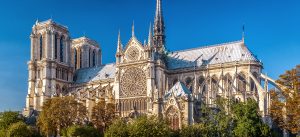
Photo © www.bigstockphoto.com
French Senators have stipulated Paris’ iconic Notre Dame Cathedral must be restored exactly how it was before the massive fire destroyed much of the historic landmark.
The French Senate has now approved the restoration bill that was already passed by the French Parliament to allow work on the cathedral to be completed in time for the Paris Olympics in 2024, but added a clause specifying it must be restored to its original condition, striking a blow to France’s Prime Minister Édouard Philippe’s idea to have an international architectural competition to redesign the roofline of the cathedral, reports French news site The Local.
The Senators have also taken out a clause from the bill that would give the government the power to override regulations on planning, environmental and heritage protection, and public tenders. Finally, the bill allows the government to create an établissement public à caractère administratif (EPA), or public project, to manage the reconstruction. This EPA will be placed under the authority of the France Ministry of Culture, according to The Local.





Glad to see the French Senate has more common sense than the lot of self-important architects and designers wanting to make their mark on an icon.
I’m saddened to hear the french senate has dictated Notre Dame must be restored exactly as it was. Given France’s history and nature to be creative and cutting edge I was looking forward to a really innovative recreation, not a dogmatic restoration. I thought i heard that the structure that burned was actually not the original design either.
As an architect I think there is justification for a contemporary take to an existing edifice. Just not here.The 19th century spire addition /reconstruction was quite awesome compositionally. Leave it to future generations to change it. Most likely it will be moot in any case when in 2099 the Seine has risen past the top of the portals!
As an architect who studied Historical Preservation in grad school, I must ask the question: to which time period do you preserve to? Notre Dame is almost 900 years old, and had been burned, renovated, and altered many times. Architecture is living and evolving; to pick a random period in time to dictate any historical building’s evolution termination point is short sighted. Architecture should reflect its time, its place, and its context. The burning, as tragic as it was, is but another chapter in the long history of Notre Dame, and she must move forward once again in 2019.
I’m an architect as well and much of my work is based in Berkshire County, Massachusetts which predominantly includes historic restoration of many of the political iconic buildings in the area. In my experiences and knowledge of restoration and preservation, architectural restoration should always consider its evolution over time so definitely agree there. However, when restoring a structure because of a tragedy such as this, it really should be restored to what it was most recently (even though it may not be the original because this is in fact paying homage to its evolution over time). When you add something new, that is when new chapters come into play. In fact, its appropriate to incorporate contemporary or modern architecture when adding onto historic structures because this clearly separates the old vs. the new aesthetically. I don’t think this is the case here. You really want to restore it, not simply renovate it.
Interesting directive from the French Senate. “Notre Dame must be restored exactly how it was.” Does that include the giant timber framing harvested from trees that 200-300 years old at the time they were harvested for the 800-900 year old structure? Where will they be sourced? The roof framing that was consumed by flames was a re-framing of an earlier structure, which proved to be inadequate. Engineering was a practice of trial and error. Was a structural analysis ever performed on the wood structure before it was consumed by flames? Perhaps, in addition to replicating the structure’s aesthetics, consideration should be given as to how to re-structure the roof. The new structure could have a very strong influence on recapturing, or augmenting the building’s aesthetics.